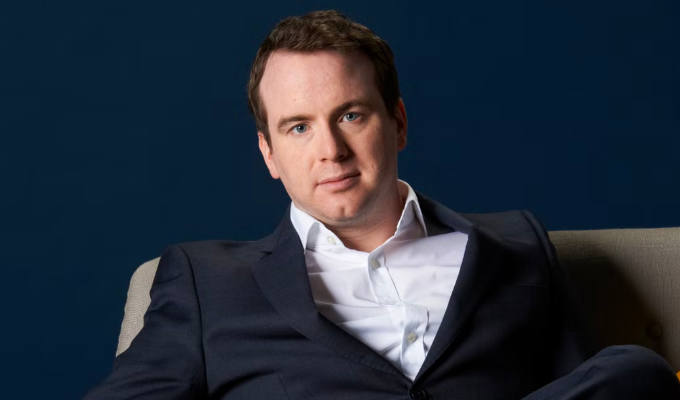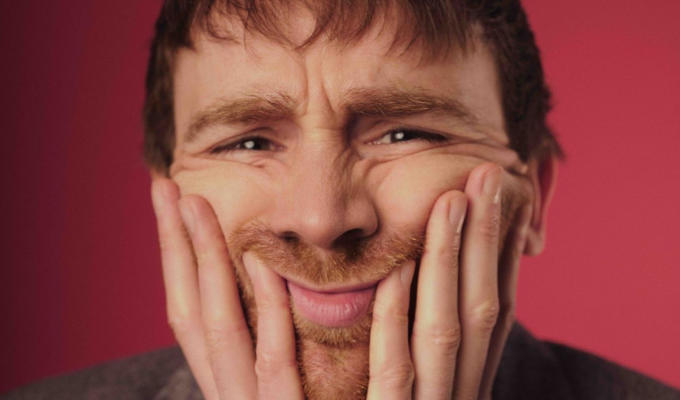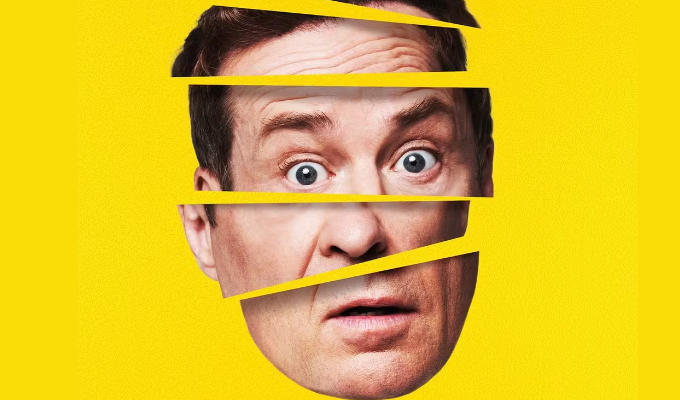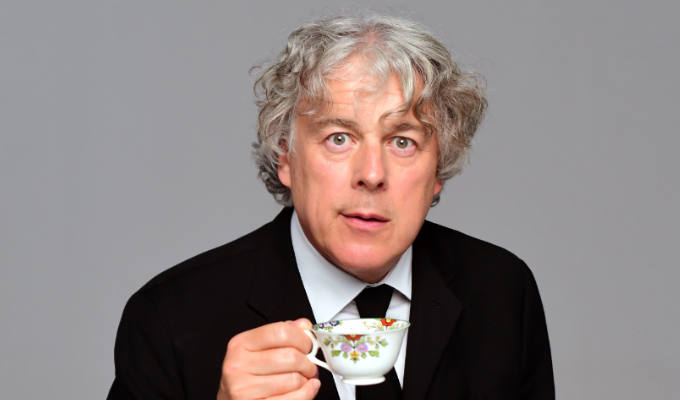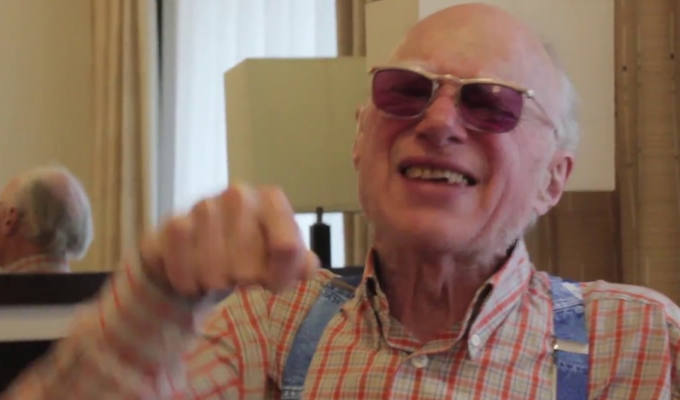
Bob Flag, one of the true originals of British comedy
Kim Wells pays tribute to a 'multi-dimensional' madcap entertainer
Kim Wells pays tribute to Bob Flag who died last August, aged 92. Kim compered the Earth Exchange Cabaret in Highgate, North London, from 1980 to 1989, one of the very first alternative comedy venues in London. Bob frequently performed there, both as part of a musical comedy duo and with Kim doing a mind-reading act. Kim also guested at two of Bob's regular venues – the Kings Head in Islington in the 1980s and the Lincoln Lounge in Kings Cross in the late 1990s and the Noughties.
It’s the 1980s. In an ‘alternative’ enclave - a vegetarian restaurant housed in a licensed squat in the Archway Road, Highgate, an audience awaits the start of Monday night’s Earth Exchange Cabaret.
A policeman walks in, reads a car registration number from his notebook, asks whose it is and, when someone gingerly owns up, snaps, rather ungraciously, ‘Move it!’.
He moves from table to table examining the contents of the ashtrays. Some of the audience are undoubtedly marihuana users but even among those who have become respectable there is still enough paranoia left over from the hippy era to make them apprehensive.
Moving to the floor near the fireplace that serves as the stage, this convincing embodiment of law-and-order suddenly tears off his trousers to reveal a pair of gold lamé shorts, picks up a saxophone and starts playing frenetically, accompanied by his keyboard player, B.A. Loon.
Bob Flag was a man who, when he broke through the fourth wall, took no hostages. His most menacing entrance was when, dressed as a fireman, he burst through the door from the street pointing a high-powered hose at the horror-struck audience and shouting ominously: ‘Where is it?’
I first met Bob Flag in 1980 when he turned up at the venue asking to do a try-out spot. Thinking he was a bit unhinged (he had a slightly manic look), I initially refused, only to relent when he asked if he could go on before the cabaret started.
The first thing he said to the rather scant audience, eating their dinners, was ‘I'm on special release from Rampton', the high-security psychiatric hospital, and then proceeded to give an account of his mental problems. My alarms bell started ringing as my fears appeared to be confirmed. But, unlike myself, the audience didn’t seem a bit concerned. It was only later when I went to see his full music- and prop-based act that I realised someone I had initially thought a lunatic might well be a genius.

Although Bob had many strings to his bow, artistically he was best located in the comic jazz band tradition. He occasionally played with offshoots of the Bonzo Dog Doo-Dah Band, including Bob Kerr’s Whoopee Band and The Bill Stickers Will Be Band. He mainly performed with just a keyboard player. Despite having only a two-man line up, he was still able to capture much of the flavour - and chaos - of these bands.
He’d bring bags full of costumes and props for each gig. At his flat, there was virtually no room to sit as it was crammed full with props.
For his routine about Jacques Cousteau, the underwater naturalist, he had a large blue backdrop, painted with wavy white lines to represent the sea. This was strung between two poles that he asked two members of the audience to jiggle about to simulate the motion of the waves. He wore a striped Edwardian bathing costume and a snorkel mask. He pretended to swim between plastic fishes that dangled down on strings from a bendy pole he had somehow attached to the top of head. As he swam, he sang (to the tune of ‘Je t’aime’):
‘My name it eez Jacques, I’m a sex maniac,
There must be down ‘ere, a fish who eez queer,
A lesbian bream with whom I can cream …'
At one point, he would break into the song to say: ‘We are sending down four skin divers, we are going to circumcise a whale.’
Wonderful stuff. The fact that he’d gone to so much trouble with his props and staging – and then only succeeded in producing something completely over-the-top and not very convincing - made it all the more absurd and funnier.
Bob was a multi-skilled performer, trying all sorts of formats and trying to master all kinds of skills. A veritable jack-of-all-trades. Bob played sax and drums, sang, clowned, donned costumes and wigs to impersonate celebrities and did ventriloquism.
He called this ‘multidimensional entertainment’. He sometimes tried his hand at stand-up. According to Tony Allen, he ‘stole the show’ on the opening night of The Comedy Store. He could even dance. He once did a very skilful and convincing simulation of Michael Jackson’s moonwalk to the song Urban Spaceman, dressed as an alien wearing an ET mask.
He used to combine all these skills at his weekly gigs with B. A. Loon at The King’s Head in Islington in the 1980s, where each week he would structure a whole new show around a topical theme, often writing new material for it. For instance, in 1981, he targeted the conference of the newly formed Social Democratic Party at Frinton-on-Sea. He sang a song whose lyrics he and I co-wrote about the so-called Gang of Four: ‘The grand old gang of four they had ten thousand men, they marched them up to the top of the hill and they marched them down again. And when they were left they were wrong, and when they were wrong they were right, and when they were somewhere in between, they were in there nice and tight. Ouch!’
While I made a speech as David Owen, he went outside and changed into a punk outfit with a boot polish brush stuck to his head, which was meant to resemble a Mohican hairstyle. He stood menacingly at the back, gradually provoking laughter among some of the audience as they began to realise he was there. He then pulled out a gun and shot me. Again dramatically breaking through the fourth wall. 360 degrees theatre.
One of my favourite routines was his parody of the rock road song, Route 66: ‘If you wanna motor north-west, Take my way it’s the highway that’s the best, Get your kicks by taking the M6... If you wanna go to Preston, The M6 is the best ‘un, Birmingham City looks Oh so pretty .... Check your water, oil, grease – that’s in the cafeteria, watch out for bacteria ...You get there by taking the M1, all the while with your back to the sun…'
And when you reach the junction ‘you fork off, and fork off, and fork off…'. By the Watford Gap, the romance evoked by the American road song is fading fast and at Spaghetti Junction any lingering trace is completely blown away in a puff of bathos. Bob would perform this wearing a leather motoring helmet and goggles, hooting a horn and holding a steering wheel. He was never under-propped.
Bob was always keen to make his shows topical. Rather fortuitously, he was performing at an Argentinian restaurant the day the Falkland Islands were invaded. He got the diners playing maracas, went outside and came back in to ‘liberate’ the restaurant, dressed as a Royal Navy Admiral. He had spent all day writing a new show, mainly adapting old material to fit this theme.
Bob played the sax remarkably well. He had been in The Riot Squad, a 1960s rock band, along with David Bowie. His propensity for acting out his songs using props and costumes may well have originated from his brief working relationship with Bowie who joined the band for a month or so in 1967.
They illustrated one particularly pain-racked pop song with a sado-masochistic dance in which Bowie followed Bob around the stage, hitting his backside violently with a whip. (Bob told me he made sure he was always well padded-up.) Bob showed me a picture of him and Bowie sitting together on a sofa. They talked about doing a double act but Bowie was edging towards fame and moved on. Bob had a tape of some studio recordings he and Bowie had done together.

Bob had enlisted in the Royal Marines as a bandsman at 16 and served in The Korean War, loading the guns on a warship. He had signed a contract at 16 that tied him in for seven years. This was something he came to regret. He did a wonderful parody of Kipling’s If poem, no doubt informed by his experience of the chaos and confusion of battle. It ended: ‘If you can keep your head when all about you are losing theirs ... then ... you’ve completely misread the situation.’
Perhaps a left over from his military days was his proclivity for using explosives on stage. He once put one under the stool of the unsuspecting B. A. Loon, detonating it remotely a minute or so into the first number. He told me it was to 'wake him up’.
He once half deafened me for a week during a performance of our mind-reading act. The explosive charge was in the helmet he stuck over my head. This contained lots of wires, valves, TV aerials and flashing lights. It was supposedly a ‘mind transplantation machine’.
He re-enacted the sinking of The General Belgrano in The Falklands War. He wheeled on a shopping trolley that was decked out to look (very vaguely) like a submarine. He stuck up a framed picture of the sea with a cut-out replica of a warship – supposedly the Belgrano - superimposed on it. He then fired ‘torpedoes’ – pink balloons that he pumped up on the ‘submarine’ and released towards the picture. Shortly afterwards he detonated a mini-explosive charge underneath the ‘Belgrano’ that caused it to tilt downwards in a flash of flame. Very much an anti-climax, given the big build up and elaborate props. But this made it all the funnier.
He used quite a powerful explosive charge in the DIY booby trap he set up in the entrance hall of his burglar-prone, inner city flat. If someone broke into the flat and stood on the doormat it caused an almighty explosion whose sound was amplified by a metal hood suspended from the ceiling. A sign would then unfurl saying ‘The next one will kill you'. Unfortunately one day he forgot to deactivate it before he stepped on the mat, deafening himself for a week.
Bob was a perfectionist with a comic eye obsessed with getting it right - but not quite right - when it came to his props and costumes. They were often unnecessarily overcomplicated, deliberately amateurish, tacky or makeshift - and sometimes grotesque. He sometimes donned a hideous mask of a woman’s head attached to a bare busted chest – resembling a nautical figurehead - as he frenetically played his sax. That was stolen from him at Earth Exchange – he blamed feminists.
In his Krisis Kabaret at the Lincoln Lounge in Kings Cross in the late 1990s and Noughties, he impersonated Stevie Wonder by wearing a black knitted tea cosy over his head with holes cut out for his eyes and lips; for Cherie Blair, he placed glass eyes in his eye sockets (securing them by an elastic band around his head) and covered his own lips with garishly red plastic ones.
Comedy thrives on threat: according to Arthur Koestler, the laughter generated by a gag is in proportion to the sense of threat discharged. Bob excelled at exploiting this. Once at one of Bob's King’s Head gigs, the landlord was trying to get a very boisterous audience member to leave. It got very heavy. Immediately after the latter had been forced to leave, Bob said ‘We have two special guests tonight. The first one has just been thrown out.’ This got a massive laugh and totally discharged the tense atmosphere.
In terms of Koestler’s theory, the humour here came from the ‘bisociation’ of two normally unrelated contexts: those of barroom aggression and theatre. Bob cleverly switched the former to the latter, discharging the lingering sense of threat in the process.
Bob and I performed a mind-reading act together which I had devised with help from my father who was a talented amateur conjuror. I appeared under the name of Professor Harry Stottle and Bob as Archie Medies or pioneering mind-transplanter, Doctor Christiaan Bonehard.
The act mainly involved the Professor with his head stuck in a ‘total deprivation chamber’ (a cardboard box perched on my head to stop me seeing anything) saying which playing cards audience members were holding up and later which clothes they were wearing.
We used to rehearse the verbal codes as we walked across Hampstead Heath, with him ‘telepathetically’ giving me the colour and type of clothing of passers-by. One trick we used was to memorise the outfits of some audience members on the front row before the act started and have a code for each person. Once I started describing the wrong person in detail which caused a lot of laughter, especially when I continued regardless. I heard laughter so I just carried on.

The act started with a big hype about how big and wondrous was the professor’s mind. Pointing to my brain, Bob would say ‘There are more cells in there than the whole of Wormwood Scrubs.’ The Professor would then limber up with a ‘metal warm-up session’ - fielding daft questions like ‘Professor, what is Heisenberg's Uncertainty Principle?’… ‘I’m not sure’... ‘Correct, Professor’.
The act would end by my supposedly remembering the full four volume London telephone directory. Several audience members would together choose a particular directory and page and seemingly, without my being told either, I would give the first name, address and telephone number on that page. It did involve using verbal codes but what made it truly impressive was it also involved an ingenious (but simple) conjuring trick suggested by my father and slickly executed by Bob.
Bob was part of Ken Campbell’s Road Show in the 1970s. Bob told me about two of the routines he’d participated in. One involved trying to beat the world record for having a ferret down the front of your trousers. It was explained that ferrets tended to target ‘dangly bits’. The referee would hold a stopwatch whist the contestant writhed and pretended to wince in pain as the ferret seemingly ran amuck around his underpants. Bob said he always insisted on some extra-thick padding in the lining between the ferret and his ‘bits’.
In the ‘Waiter there’s a sock in my soup’ routine, Bob, a customer eating soup in a restaurant, would fish out a sock with his spoon. He’d call over the waiter who would pull up his trousers to reveal one sock was missing. The waiter would then take the sock out and wring it out into the soup. He would put it on whilst Bob continued nonchalantly to sip the soup. Bob said he always insisted on a clean sock.
Bob had a thing about socks. There was one ‘remarkable feat’ involving a sock that we included in the mind-reading act. Bob would borrow a sock from an audience member and put it on one foot. He wore an overshoe containing an explosive charge with a reinforced barrier between the overshoe and his real shoe which was designed to protect his foot. His lower leg would then be covered with a towel.
As Professor Harry Stottle, I would attempt to peer ‘paranormally’ through this impenetrable covering to ascertain the colour of the sock (which I would already know via a verbal code). ‘Right,' I’d say, ‘I’m putting the flux on the sock now. For the flux sake, silence please!’. When the hypothetical ‘flux’ had had sufficient chance to build up, Bob’s shoe would explode and belch acrid smoke. I would then give the correct colour of the sock (say green). Bob would then pull out the smoking, very charred and tattered remains of a blackened sock from a different compartment and say: 'Correct, green - a very, very, very dark shade of green’.
He would say to the luckless sock owner: ‘Don’t worry, Sir, I can replace it with an even better sock’ and he’d give him a cheap, non-matching sock from Woolworths. He’d be left to wait till the end to find out he was going to get his original sock back. Once Bob made the explosive charge too strong - a common fault of his - and slightly burnt his foot.
Another string to Bob’s bow was acting. He appears in several films such as Walter (1982) where, alongside of Ian McKellen, he very convincingly played a manic mentally disabled man in a psychiatric hospital; and The Cold Light of Day (1989) where he played the central character, the serial killer Dennis Nilsen, below.

He appeared fleetingly in the opening sequences of The Calendar Girls as the man from The Milk Marketing Board. Although there was no intention of using it, he delivered a well-researched, highly technical lecture on milk and marketing. Such was its incongruity (and mock seriousness), it had the cast in stitches.
He was the face of Big Brother in the poster advertising the film 1984. In this, his eyes were all-seeing and menacing. When performing or amused, they would mischievously dart from side to side.

Bob didn’t measure his success solely in terms of the number of laughs he got. Like the Dadaists, he wanted to discombobulate and challenge the audience – do something that would ‘strike them strange’, ‘shake them up’ and make then think out-of-the-box. On evenings when the audience seemed a bit constipated laugh-wise, he would say, by way of post-mortem, ‘They didn’t know what to make of that!’ – as if this was a great achievement.
In 1979 Bob met with other fringe and alternative performers like Tony Allen and Alexei Sayle to set up a talent pool of performers under the title, Alternative Cabaret. The intention was to organise gigs in various venues around London. Bob organised the first Alternative Cabaret at the Pindar of Wakefield pub in Kings Cross. It then moved to the Elgin in Ladbroke Grove. After three weeks, Bob became disenchanted and left. The reason he gave was: ‘I’m into shit, chaos and nonsense and you lot are into something tighter..’ Bob, ever the maverick, clearly wanted more freedom to do his own thing.
He valued artistic freedom and continuous creative innovation and development over fame. As an artist, Bob was constantly evolving, writing new material, doing it once or twice, then moving on. He spent little time perfecting his routines. He was continually trying new forms and finding new outlets for his creativity. And sometimes he tried to juggle far too many balls at once. Consequently his performances often lacked polish and smoothness of flow, sometimes, for instance, losing comic momentum as he scrabbled in his bag for the right prop. (Tony Allen said he was 'a fan [of Bob] when he got it right.’) But when he was on a roll, firing on all cylinders, it could be exhilarating. To see him in the full flood of the creative process, producing prop after prop, frenetically donning and doffing costumes, singing and playing great music - and, all the while, with a mischievous grin on his face – was stupendous. It was all the more remarkable when one realised that much of this stuff was new - fresh off the drawing board. Much of it would never be seen again and, if it were, it would be in another context and quite different.
Bob lived in Japan with his Japanese wife, Taki, for the final 13 or so years of his life. He carried on performing, appealing to the Japanese who, despite their devotion to conformity, also loved madcap comedy and eccentricity in general. He was one of great originals of British comedy who sadly didn’t enjoy the recognition he richly deserved.
• Bob Flag’s musical memoirs Drumstick are available on Amazon.
Published: 22 May 2024



